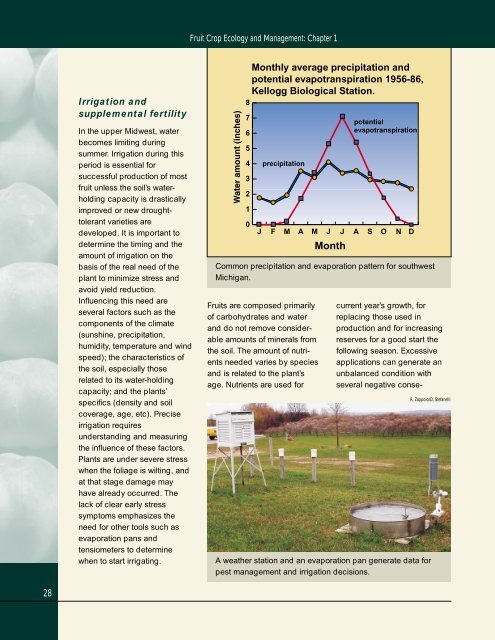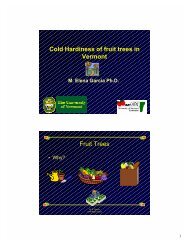Fruit Crop Ecology and Management - UVM Apple Orchard
Fruit Crop Ecology and Management - UVM Apple Orchard
Fruit Crop Ecology and Management - UVM Apple Orchard
You also want an ePaper? Increase the reach of your titles
YUMPU automatically turns print PDFs into web optimized ePapers that Google loves.
28<br />
Irrigation <strong>and</strong><br />
supplemental fertility<br />
In the upper Midwest, water<br />
becomes limiting during<br />
summer. Irrigation during this<br />
period is essential for<br />
successful production of most<br />
fruit unless the soil’s waterholding<br />
capacity is drastically<br />
improved or new droughttolerant<br />
varieties are<br />
developed. It is important to<br />
determine the timing <strong>and</strong> the<br />
amount of irrigation on the<br />
basis of the real need of the<br />
plant to minimize stress <strong>and</strong><br />
avoid yield reduction.<br />
Influencing this need are<br />
several factors such as the<br />
components of the climate<br />
(sunshine, precipitation,<br />
humidity, temperature <strong>and</strong> wind<br />
speed); the characteristics of<br />
the soil, especially those<br />
related to its water-holding<br />
capacity; <strong>and</strong> the plants’<br />
specifics (density <strong>and</strong> soil<br />
coverage, age, etc). Precise<br />
irrigation requires<br />
underst<strong>and</strong>ing <strong>and</strong> measuring<br />
the influence of these factors.<br />
Plants are under severe stress<br />
when the foliage is wilting, <strong>and</strong><br />
at that stage damage may<br />
have already occurred. The<br />
lack of clear early stress<br />
symptoms emphasizes the<br />
need for other tools such as<br />
evaporation pans <strong>and</strong><br />
tensiometers to determine<br />
when to start irrigating.<br />
<strong>Fruit</strong> <strong>Crop</strong> <strong>Ecology</strong> <strong>and</strong> <strong>Management</strong>: Chapter 1<br />
8<br />
7<br />
6<br />
5<br />
4<br />
3<br />
2<br />
1<br />
0<br />
Monthly average precipitation <strong>and</strong><br />
potential evapotranspiration 1956-86,<br />
Kellogg Biological Station.<br />
J<br />
precipitation<br />
Common precipitation <strong>and</strong> evaporation pattern for southwest<br />
Michigan.<br />
<strong>Fruit</strong>s are composed primarily<br />
of carbohydrates <strong>and</strong> water<br />
<strong>and</strong> do not remove considerable<br />
amounts of minerals from<br />
the soil. The amount of nutrients<br />
needed varies by species<br />
<strong>and</strong> is related to the plant’s<br />
age. Nutrients are used for<br />
F<br />
M<br />
A<br />
M<br />
J<br />
J<br />
Month<br />
potential<br />
evapotranspiration<br />
A<br />
S<br />
O<br />
current year’s growth, for<br />
replacing those used in<br />
production <strong>and</strong> for increasing<br />
reserves for a good start the<br />
following season. Excessive<br />
applications can generate an<br />
unbalanced condition with<br />
several negative conse-<br />
A weather station <strong>and</strong> an evaporation pan generate data for<br />
pest management <strong>and</strong> irrigation decisions.<br />
N<br />
D<br />
R. Zoppolo/D. Stefanelli



